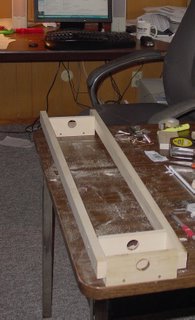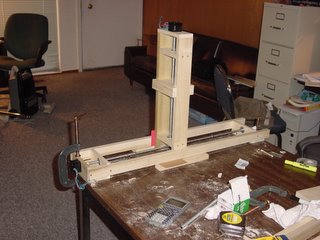Saturday, February 04, 2006
Moving right along...
Once I decided to do the mockup of the prototype RepStrap in poplar wood instead of aluminum the pace of design development has picked up enormously. The poplar I am using is milled cabinet quality which means that with this fine grained a wood it has a dimensional accuracy of about a half mm. I'm giving it a shade less than 2 mm fit so that I can account for humidity changes in the wood. We are in the rainy season here, so I expect that the assemblies will shrink a little when it is over in late March.
As I mentioned last time, I had problems with the threaded rod not being quite straight. I sorted out 95% of that by straightening the rod, but finally decided that I needed some guideways to damp out as much of the wobble in the system as possible. Rather than going for steel rods I decided to just use more poplar. Oh yes, hereafter I am going to use AoI coordinate naming conventions.
Here is the z-axis with guide rails.
 I have positioned them above the working surface {x-y} so that they can provide for stability not only against rotation around the z-axis, but also the x and y axes.
I have positioned them above the working surface {x-y} so that they can provide for stability not only against rotation around the z-axis, but also the x and y axes.
Here is the y-axis positioner.
 Note the rails inhibiting rotation around the x-axis.
Note the rails inhibiting rotation around the x-axis.
Now you can see the two integrated.

The y-axis slides back and forth in the z direction like a drawer.
What is not shown yet is the positioning collar for the y-axis that supports the x-axis positioning stage. I want the x-axis stage to fit around and slide down over the y-axis like a collar so that there is as as little eccentric loading of the system as possible.
Of course, there are two z-y assemblies like this that support the x-axis stage between them like a beam. I will pin connect the x-axis stage to one of the y-stages and use a sliding joint for the other so that we do not transfer any torques from one of the z-y assemblies to the other.
So far the system is modular and pretty much demountable. I am currently working out how to keep that demountability happening in the collar on the y-axis that supports the x-axis stage. I think I have a way, but I will have to purchase a few long bolts and wing nuts to make it happen. So it goes.
Here is the combined z-y axes stages with the bracket for supporting the x-axis stage in place.

The system is also scaleable. Using American parts and increasing the diameter of the threaded rod I can easily push the x-axis out to 1800 mm. Do., the z-axis. The y-axis stage is a little trickier, though.
As I mentioned last time, I had problems with the threaded rod not being quite straight. I sorted out 95% of that by straightening the rod, but finally decided that I needed some guideways to damp out as much of the wobble in the system as possible. Rather than going for steel rods I decided to just use more poplar. Oh yes, hereafter I am going to use AoI coordinate naming conventions.
Here is the z-axis with guide rails.
 I have positioned them above the working surface {x-y} so that they can provide for stability not only against rotation around the z-axis, but also the x and y axes.
I have positioned them above the working surface {x-y} so that they can provide for stability not only against rotation around the z-axis, but also the x and y axes.Here is the y-axis positioner.
 Note the rails inhibiting rotation around the x-axis.
Note the rails inhibiting rotation around the x-axis.Now you can see the two integrated.

The y-axis slides back and forth in the z direction like a drawer.
What is not shown yet is the positioning collar for the y-axis that supports the x-axis positioning stage. I want the x-axis stage to fit around and slide down over the y-axis like a collar so that there is as as little eccentric loading of the system as possible.
Of course, there are two z-y assemblies like this that support the x-axis stage between them like a beam. I will pin connect the x-axis stage to one of the y-stages and use a sliding joint for the other so that we do not transfer any torques from one of the z-y assemblies to the other.
So far the system is modular and pretty much demountable. I am currently working out how to keep that demountability happening in the collar on the y-axis that supports the x-axis stage. I think I have a way, but I will have to purchase a few long bolts and wing nuts to make it happen. So it goes.
Here is the combined z-y axes stages with the bracket for supporting the x-axis stage in place.

The system is also scaleable. Using American parts and increasing the diameter of the threaded rod I can easily push the x-axis out to 1800 mm. Do., the z-axis. The y-axis stage is a little trickier, though.
Comments:
<< Home
It's good to see thigs developing like this. If you're worried about shrinkage, replace or augment the polar with aluminium angle. It's relatively cheap and easy to work with.
How practical is it to "cheat" and use the bearings in the stepper motor for one end of the drive rods?
It works OK with the relativley narrow stuf I'm using, but yours are much more sturdy.
Vik :v)
How practical is it to "cheat" and use the bearings in the stepper motor for one end of the drive rods?
It works OK with the relativley narrow stuf I'm using, but yours are much more sturdy.
Vik :v)
How practical is it to "cheat" and use the bearings in the stepper motor for one end of the drive rods?
I'm sure it's very possible. My own decision was, however, to limit the stepper to only providing controlled power and not to make it do anything like that kind of double duty. That was purely a personal choice.
The good Lord knows that at US$3.49/unit the bearings in my design will cost more than the steppers. :-o
I'm not too worried about bearings, though. Mine cost a lot mostly because I was too lazy to mill down my 3/8" threaded rods on the ends to 8 mm. If I had done that I would have been able to buy skateboard bearings, which are widely available and standardised at 8 mm, for about US$1.25/unit for some pretty decent bearings.
They typically come in packages of 8 for anywhere from US$9-50 depending on the level of technology therein.
If you shop, though, you can run across deals like this...
http://cgi.ebay.com/ws/eBayISAPI.dll?ViewItem&item=7583581936&category=25284
...which cost about US$0.15/unit.
I'm sure it's very possible. My own decision was, however, to limit the stepper to only providing controlled power and not to make it do anything like that kind of double duty. That was purely a personal choice.
The good Lord knows that at US$3.49/unit the bearings in my design will cost more than the steppers. :-o
I'm not too worried about bearings, though. Mine cost a lot mostly because I was too lazy to mill down my 3/8" threaded rods on the ends to 8 mm. If I had done that I would have been able to buy skateboard bearings, which are widely available and standardised at 8 mm, for about US$1.25/unit for some pretty decent bearings.
They typically come in packages of 8 for anywhere from US$9-50 depending on the level of technology therein.
If you shop, though, you can run across deals like this...
http://cgi.ebay.com/ws/eBayISAPI.dll?ViewItem&item=7583581936&category=25284
...which cost about US$0.15/unit.
Dang, at a price like that, I can hardly justify using bronze bushings. I'll have to pick up some of those!
Post a Comment
<< Home
